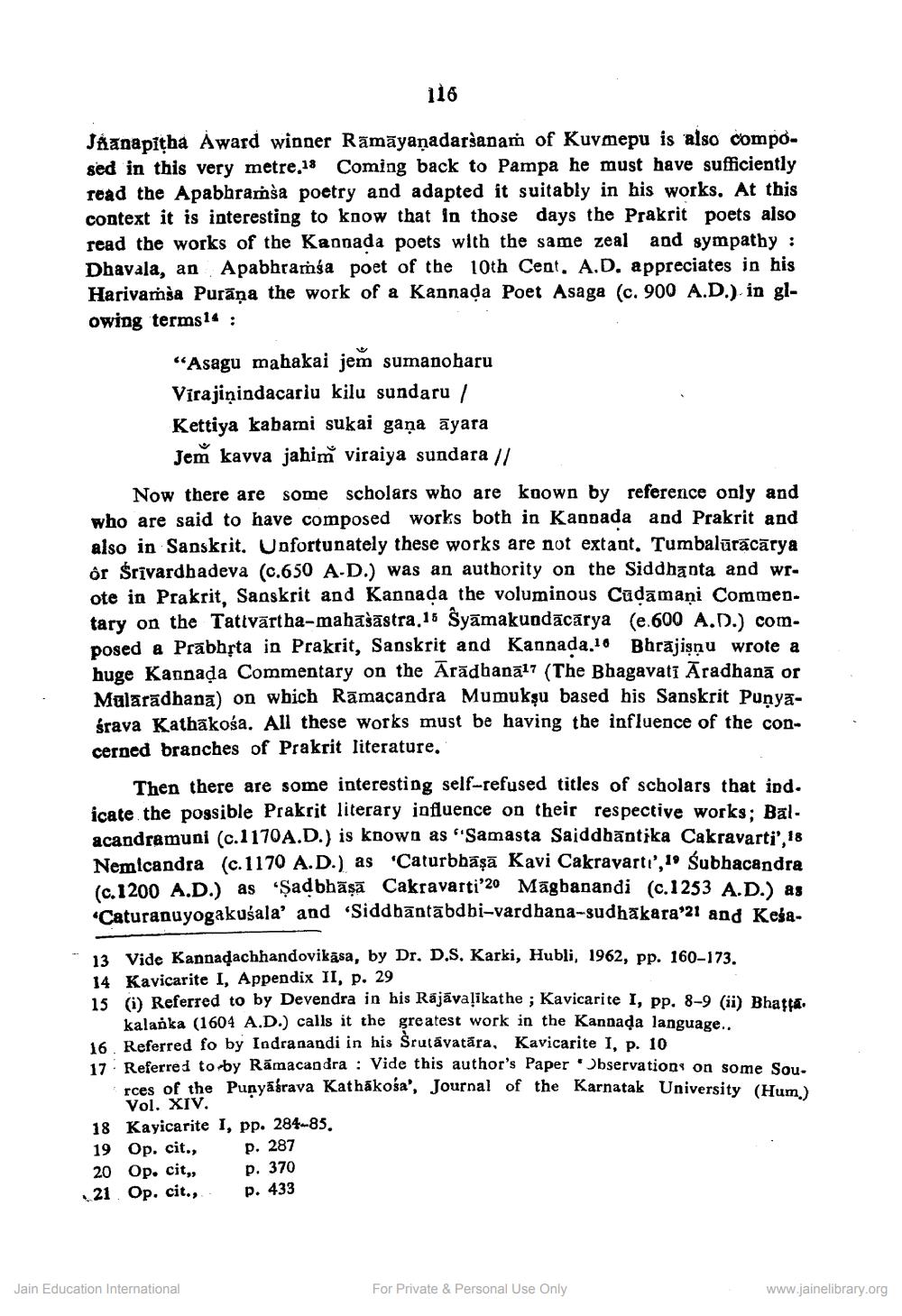________________
116
Jhanapitha Award winner Ramāyaṇadarsanam of Kuvmepu is also composed in this very metre,18 Coming back to Pampa he must have sufficiently read the Apabhramša poetry and adapted it suitably in his works. At this context it is interesting to know that in those days the Prakrit poets also read the works of the Kannada poets with the same zeal and sympathy: Dhavala, an Apabhramsa poet of the 10th Cent. A.D. appreciates in his Harivaṁša Purāņa the work of a Kannada Poet Asaga (c. 900 A.D.) in glowing terms16 :
“Asagu mahakai jem sumanoharu Virajiņindacariu kilu sundaru / Kettiya kabami sukai gaņa āyara Jem kavva jahim viraiya sundara ||
Now there are some scholars who are koown by reference only and who are said to have composed works both in Kannada and Prakrit and also in Sanskrit. Unfortunately these works are not extant. Tumbalūrācārya ôr Śrīvardhadeva (c.650 A.D.) was an authority on the Siddhanta and wr. ote in Prakrit. Sanskrit and Kannada the voluminous Cudamani Commentary on the Tattvārtha-mahasāstra.16 Syāmakundācārya (e. 600 A.D.) com. posed a Prabhịta in Prakrit, Sanskrit and Kannada.16 Bhrājisnu wrote a huge Kannada Commentary on the Ārādbanāl? (The Bhagavati Āradhanā or Malarādhana) on wbich Rāmacandra Mumuksu based his Sanskrit Punyaśrava Kathakośa. All these works must be having the influence of the concerned branches of Prakrit literature,
Then there are some interesting self-refused titles of scholars that ind. icate the possible Prakrit literary influence on their respective works: Balacandramuni (c.1170A.D.) is known as "Samasta Saiddhāntika Cakravarti',18 Nemicandra (c. 1170 A.D.) as 'Caturbhāşā Kavi Cakravarti',"' Subhacandra (c.1200 A.D.) as "Şadbhāṣā Cakravarti'20 Mágbanandi (c. 1253 A.D.) as «Caturanuyogakusala' and 'Siddhāntabdbi-vardhana-sudhakara'21 ans
- 13 Vide Kannadachhandovikasa, by Dr. D.S. Karki, Hubli, 1962, pp. 160-173.
14 Kavicarite I, Appendix II, p. 29 15 ) Referred to by Devendra in his Rājāvaļikathe ; Kavicarite I, pp. 8-9 (ii) Bhatta,
kalanka (1604 A.D.) calls it the greatest work in the Kannada language.. 16. Referred fo by Indranandi in his Šrutávatára, Kavicarite I, p. 10 1: Referred to by Rāmacandra : Vide this author's Paper Observations on some Sou.
rces of the Punyaśrava Kathakośa', Journal of the Karnatak University (Hum
Vol. XIV. 18 Kayicarite I, pp. 284-85. 19 Op. cit., p. 287 20 Op. cit., p. 370 21. Op. cit., p. 433
Jain Education International
For Private & Personal Use Only
www.jainelibrary.org




